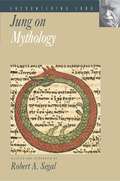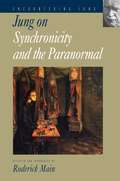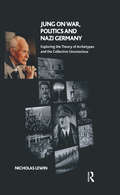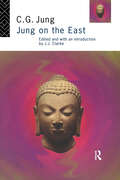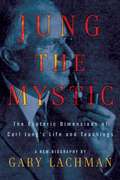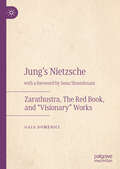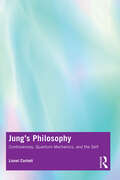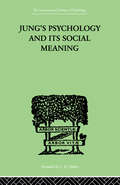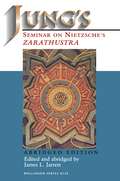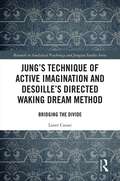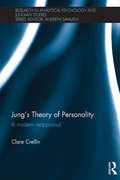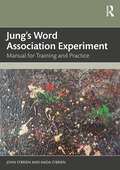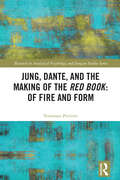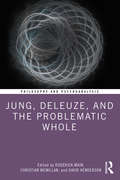- Table View
- List View
Jung on Christianity (Encountering Jung)
by C. G. JungC. G. Jung, son of a Swiss Reformed pastor, used his Christian background throughout his career to illuminate the psychological roots of all religions. Jung believed religion was a profound, psychological response to the unknown--both the inner self and the outer worlds--and he understood Christianity to be a profound meditation on the meaning of the life of Jesus of Nazareth within the context of Hebrew spirituality and the Biblical worldview. Murray Stein's introduction relates Jung's personal relationship with Christianity to his psychological views on religion in general, his hermeneutic of religious thought, and his therapeutic attitude toward Christianity. This volume includes extensive selections from Psychological Approach to the Dogma of the Trinity," "Christ as a Symbol of the Self," from Aion, "Answer to Job," letters to Father Vincent White from Letters, and many more.
Jung on Death and Immortality (Encountering Jung #3)
by C. G. Jung"As a doctor, I make every effort to strengthen the belief in immortality, especially with older patients when such questions come threateningly close. For, seen in correct psychological perspective, death is not an end but a goal, and life's inclination towards death begins as soon as the meridian is past."--C.G. Jung, commentary on The Secret of the Golden Flower ? Here collected for the first time are Jung's views on death and immortality, his writings often coinciding with the death of the most significant people in his life. The book shows many of the major themes running throughout the writings, including the relativity of space and time surrounding death, the link between transference and death, and the archetypes shared among the world's religions at the depths of the Self. The book includes selections from "On Resurrection," "The Soul and Death," "Concerning Rebirth," "Psychological Commentary on The Tibetan Book of the Dead" from the Collected Works, "Letter to Pastor Pfafflin" from Letters, and "On Life after Death."
Jung on Evil (Jung On Ser.)
by C. G. JungIlluminating selections from Jung&’s writings on the nature of evilWell-known for his articulation of the &“shadow side&” of human individuality and culture, C. G. Jung wrote a great deal about the question of evil throughout his life and in scattered places in his work. In this book, Murray Stein brings together key selections of Jung&’s writings on the subject. In Jung&’s early work on the unconscious, he considered the role of evil in the mental processes of the severely disturbed. Later, he viewed the question of moral choice within the framework of his ideas about archetypes and discussions about moral choices, conscience, and the continual ethical reflection that is necessary for all of us. The material here includes letters to Freud and Father Victor White and writings ranging from his Answer to Job to his travel piece on North Africa.
Jung on Ignatius of Loyola’s Spiritual Exercises: Lectures Delivered at ETH Zurich, Volume 7: 1939–1940 (Philemon Foundation Series #27)
by C. G. JungJung&’s lectures on the psychology of Jesuit spiritual practice—unabridged in English for the first timeBetween 1933 and 1941, C. G. Jung delivered a series of public lectures at the Swiss Federal Institute of Technology (ETH) in Zurich. Intended for a general audience, these lectures addressed a broad range of topics, from yoga and meditation to dream analysis and the psychology of alchemy. Here for the first time are Jung&’s complete lectures on Ignatius of Loyola&’s Spiritual Exercises, delivered in the winter of 1939–1940.These illuminating lectures are the culmination of Jung&’s investigation into traditional forms of meditation and their parallels to his psychotherapeutic method of active imagination. Jung presents Loyola&’s exercises as the prime example of a Christian practice comparable to yoga and Eastern meditation, and gives a psychological interpretation of the visions depicted in the saint&’s autobiographical writings. Offering a unique opportunity to encounter the brilliant psychologist as he shares his ideas with the general public, the lectures reflect Jung&’s increasingly positive engagement with Roman Catholicism, a development that would lead to his fruitful collaborations after the war with eminent Catholic theologians such as Victor White, Bruno de Jésus-Marie, and Hugo Rahner.Featuring an authoritative introduction by Martin Liebscher along with explanations of Jungian concepts and psychological terminology, this splendid book provides an invaluable window on the evolution of Jung&’s thought and a vital key to understanding his later work.
Jung on Mythology (Encountering Jung #2)
by C. G. JungAt least three major questions can be asked of myth: what is its subject matter? what is its origin? and what is its function? Theories of myth may differ on the answers they give to any of these questions, but more basically they may also differ on which of the questions they ask. C. G. Jung's theory is one of the few that purports to answer fully all three questions. This volume collects and organizes the key passages on myth by Jung himself and by some of the most prominent Jungian writers after him: Erich Neumann, Marie-Louise von Franz, and James Hillman. The book synthesizes the discovery of myth as a way of thinking, where it becomes a therapeutic tool providing an entrance to the unconscious. In the first selections, Jung begins to differentiate his theory from Freud's by asserting that there are fantasies and dreams of an "impersonal" nature that cannot be reduced to experiences in a person's past. Jung then asserts that the similarities among myths are the result of the projection of the collective rather than the personal unconscious onto the external world. Finally, he comes to the conclusion that myth originates and functions to satisfy the psychological need for contact with the unconscious--not merely to announce the existence of the unconscious, but to let us experience it.
Jung on Synchronicity and the Paranormal (Encountering Jung #1)
by C. G. JungC. G. Jung had a lifelong interest in the paranormal that culminated in his influential theory of synchronicity. Combining extracts taken from the Collected Works; letters; the autobiographical Memories, Dreams, Reflections; and transcripts of seminars, Jung on Synchronicity and the Paranormal sets out clearly his seminal contribution to our understanding of this controversial area. In his introduction, Roderick Main discusses Jung's encounters with and observations of the paranormal, the influences that contributed to his theory of synchronicity, and the central ideas of the theory itself. The selections include Jung's writings on mediumistic trance phenomena, spirits and hauntings, anomalous events in the development and practice of analytical psychology, and the divinatory techniques of astrology and the I Ching. The book also features Jung's most lucid account of his theory in the form of his short essay "On Synchronicity," and a number of Jung's less-known writings on parapsychology, his astrological experiment, and the relationship between mind and body. Jung on Synchronicity and the Paranormal addresses subjects that were fundamental to Jung's personal and professional development. Probing deeply into the theory of synchronicity, Roderick Main clarifies issues that have long been a source of confusion to Jung's readers.
Jung on War, Politics and Nazi Germany: Exploring the Theory of Archetypes and the Collective Unconscious
by Nicholas LewinThis book presents a historical examination of C.G. Jung's politics and considers the insights he provides for those seeking to understand the causes of War. It looks at how Jung applies his theories to Nazi Germany and the rise of the theories of the collective unconscious and the archetypes.
Jung on the East (Jung On Ser.)
by C.G. JungJung's interest in the East was deep-rooted and life-long, and the traditional teachings of China and India played an important role in his personal and intellectual development, as well as in the formations of the ideas and practices that are central to Jungian psychology.Jung on the East brings together key selections from his work on Buddhism, yoga and Taoism, and on such classic texts as the I Ching and The Tibetan Book of the Dead. It also includes accounts on his own journey to India.The clear and perceptive introduction sets the context for Jung's encounter with the East, and provides an excellent framework that will enable the reader to get the most out of Jung's writings in this area. The book will be of interest to everyone seeking to further their understanding both of Jung, and of Eastern thought and spirituality.
Jung the Mystic
by Gary LachmanNow in paperback, this bold new biography fills a gap in our understanding of the pioneering psychologist by focusing on the occult and mystical aspects of Jung’s thought and career. “Outstanding . . . lifts the curtain on one of the most important aspects of his remarkable life . . . fair and objective. ” —Alice O. Howell, Quest magazine “How the Swiss psychologist lived a life rich in the paranormal. ” —Los Angeles Times “A serious but comprehensible new biography of Jung and his interest in the esoteric. ” —New Age Retailer “Fascinating . . . Fully engaging from beginning to end. ” —Dell Horoscope Although he is often called the “founding father of the New Age,” Carl Jung, the legendary Swiss psychiatrist best known for his groundbreaking concepts such as the collective unconscious, archetype theory, and synchronicity, often took pains to avoid any explicit association with mysticism or the occult. Yet Jung lived a life rich in paranormal experiences—arguing for the existence of poltergeists in a debate with Sigmund Freud, participating in séances, incorporating astrology into his therapeutic work, reporting a near-death experience, and analyzing the work of pioneering ESP researcher J. B. Rhine. It is these critical experiences—often fleetingly touched on in other biographies or critical studies, and frequently used to make a case against Jung and his philosophies—that form the core of this significant new biography. .
Jung's Answer to Job: A Commentary
by Paul BishopGreeted with controversy on its publication, Answer to Job has long been neglected by many serious commentators on Jung. This book offers an intellectual and cultural context for C.G.Jung's 1952 publication.In Jung's Answer to Job: A Commentary, the author argues that such neglect is due to a failure to understand Jung's objectives in this text and offers a new way of reading the work. The book places Answer to Job in the context of biblical commentary, and then examines the circumstances surrounding its compositions and immediate reception. A detailed commentary on the work discusses the major methodological presuppositions informing it and explains how key Jungian concepts operate in the text. Jung's Answer to Job: A Commentary unravels Jung's narrative by reading it in the chronological order of the biblical events it analyses and the book to which it refers, offering a comprehensive re-reading of Jung's text. An original argument put across in a scholarly and accessible style provides an essential framework for understanding the work. Whilst taking account of the tenets of analytical psychology, this commentary underlines Answer to Job's more general significance in terms of cultural history. It will be invaluable to students and scholars of analytical psychology, the history of ideas, intercultural studies, comparative literature, religion and religious studies.
Jung's Ethics: Moral Psychology and his Cure of Souls (Philosophy and Psychoanalysis)
by Dan MerkurThis volume presents the first organized study of Jung's ethics. Drawing on direct quotes from all of his collected works, interviews, and seminars, psychoanalyst and religious scholar Dan Merkur provides a compendium of Jung’s thoughts on various topics and themes that comprise his theoretical corpus—from the personal unconscious, repression, dreams, good and evil, and the shadow, to collective phenomena such as the archetypes, synchronicity, the psychoid, the paranormal, God, and the Self, as well as his contributions to clinical method and technique including active imagination, inner dialogue, and the process of individuation and consciousness expansion. The interconnecting thread in Merkur's approach to the subject matter is to read Jung’s work through an ethical lens. What comes to light is how Merkur systematically portrays Jung as a moralist, but also as a complex thinker who situates the human being as an instinctual animal struggling with internal conflict and naturalized sin. Merkur exposes the tension and development in Jung’s thinking by exploring his innovative clinical-technical methods and experimentation, such as through active imagination, inner dialogue, and expressive therapies, hence underscoring unconscious creativity in dreaming, symbol formation, engaging the paranormal, and artistic productions leading to expansions of consciousness, which becomes a necessary part of individuation or the working through process in pursuit of self-actualization and wholeness. In the end, we are offered a unique presentation of Jung’s core theoretical and clinical ideas centering on an ethical fulcrum, whereby his moral psychology leads to a cure of souls. Jung’s Ethics will be of interest to academics, scholars, researchers, and practitioners in the fields of Jungian studies and analytical psychology, ethics, moral psychology, philosophy, religious studies, and mental health professionals focusing on the integration of humanities and psychoanalysis.
Jung's Map of the Soul
by Murray SteinMore than a mere overview, the book offers readers a strong grounding in the basic principles of Jung's analytical psychology in addition to illuminating insights.
Jung's Nietzsche: Zarathustra, The Red Book, and “Visionary” Works
by Gaia DomeniciThis book explores C.G. Jung's complex relationship with Friedrich Nietzsche through the lens of the so-called 'visionary' literary tradition. The book connects Jung's experience of the posthumously published Liber Novus (The Red Book) with his own (mis)understanding of Nietzsche's Zarathustra, and formulates the hypothesis of Jung considering Zarathustra as Nietzsche's Liber Novus –– both works being regarded by Jung as 'visionary' experiences. After exploring some 'visionary' authors often compared by Jung to Nietzsche (Goethe, Hölderlin, Spitteler, F. T. Vischer), the book focuses upon Nietzsche and Jung exclusively. It analyses stylistic similarities, as well as explicit references to Nietzsche and Zarathustra in Liber Novus, drawing on Jung's annotations in his own copy of Zarathustra. The book then uses Liber Novus as a prism to contextualize and understand Jung's five-year seminar on Zarathustra: all the nuances of Jung's interpretation of Zarathustra can be fully explained, only when compared with Liber Novus and its symbology. One of the main topics of the book concerns the figure of 'Christ' and Nietzsche's and Jung's understandings of the 'death of God.'
Jung's Philosophy: Controversies, Quantum Mechanics, and the Self
by Lionel Corbett‘Jung’s Philosophy’ explores some of the controversial philosophical ideas that are both explicit and implicit within Jung’s psychology, comparing the philosophical assumptions between this and other psychotherapeutic traditions. Within this book, Corbett provides a useful introduction to the philosophical issues relevant to the practice of analytical psychology, and how these are viewed by different psychotherapeutic traditions. Most of the disagreement between schools of psychotherapy, and much of the comparative literature, centres around differences in theory and technique. This book takes a different, more fundamental approach by comparing schools of thought based on their underlying philosophical commitments. The author discusses the philosophical basis of various worldviews such as idealism and realism, beliefs about the nature of the psyche and the unconscious, and the mind-brain relationship, and focuses on the way in which Jung’s psychology addresses these and related issues, including the possible relevance of quantum mechanics to depth psychology. This text will be of value to practising psychotherapists and Jungian analysts, individuals undertaking the relevant training, and students in depth psychology.
Jung's Psychology and its Social Meaning: An introductory statement of C G Jung's psychological theories and a first interpretation of their significance for the social sciences (International Library Of Psychology Ser.)
by Ira ProgoffRoutledge is now re-issuing this prestigious series of 204 volumes originally published between 1910 and 1965. The titles include works by key figures such asC.G. Jung, Sigmund Freud, Jean Piaget, Otto Rank, James Hillman, Erich Fromm, Karen Horney and Susan Isaacs. Each volume is available on its own, as part of a themed mini-set, or as part of a specially-priced 204-volume set. A brochure listing each title in the "International Library of Psychology" series is available upon request.
Jung's Seminar on Nietzsche's Zarathustra: Abridged Edition (Bollingen Series (General) #637)
by James L. JarrettNietzsche's infamous work Thus Spake Zarathustra is filled with a strange sense of religiosity that seems to run counter to the philosopher's usual polemics against religious faith. For some scholars, this book marks little but a mental decline in the great philosopher; for C. G. Jung, Zarathustra was an invaluable demonstration of the unconscious at work, one that illuminated both Nietzsche's psychology and spirituality and that of the modern world in general. The original two-volume edition of Jung's lively seminar on Nietzsche's Zarathustra has been an important source for specialists in depth psychology. This new abridged paperback edition allows interested readers to participate with Jung as he probes the underlying meaning of Nietzsche's great work.
Jung's Shadow Concept: The Hidden Light and Darkness within Ourselves
by Christopher Perry Rupert TowerThis insightful volume is designed as a series of invitations towards living attentiveness, examining how we all make the “other”, through “projection” (blaming and shaming the other outside ourselves), our enemy with whom we prefer not to dialogue. All of us are faced daily with individual and collective manifestations of the Shadow – all that we fear, despise and makes us feel ashamed. Carl Jung’s concept of the Shadow, emerging as it did from his personal confrontation with the realms of his unconscious self, is one of the most important contributions he made to the understanding of humanity and to depth psychology, that realm where the focus is on unconscious processes. The contributors to this book reframe his concept in the context of contemporary Jungian thinking, exploring how the Shadow develops in an individual’s infancy and adolescence, and its culmination, where collective manifestations of the Shadow are addressed. The book offers a voyage through a series of fundamental Shadow concepts and themes including couples relationships, disease, organizations, Evil, fundamentalism, ecology and boundary violation before ending with a chapter designed to help us integrate the Shadow and hold contra-positions with patience and a tilt towards mutual understanding, rather than being locked in polarities. This fascinating new book will be of interest to the general public, Jungian analysts, scholars and therapists both in training and practice with an interest in the inner world.
Jung's Technique of Active Imagination and Desoille's Directed Waking Dream Method: Bridging the Divide (Research in Analytical Psychology and Jungian Studies)
by Laner CassarJung's Technique of Active Imagination and Desoille's Directed Waking Dream Method brings together Carl Jung’s active imagination and Robert Desoille’s "rêve éveillé dirigé/directed waking dream" method (RED). It studies the historical development of these approaches in Central Europe in the first half of the 20th century and explores their theoretical similarities and differences, proposing an integrated framework of clinical practice. The book aims to study the wider European context of the 1900s which influenced the development of both Jung’s and Desoille’s methods. This work compares the spatial metaphors of interiority used by both Jung and Desoille to describe the traditional concept of inner psychic space in the waking dreams of Jung’s active imagination and Desoille’s RED. It also attempts a broader theoretical comparison between the procedural aspects of both RED and active imagination by identifying commonalities and divergences between the two approaches. This book is a unique contribution to analytical psychology and will be of great interest for academics, researchers and post-graduate students interested in the use of imagination and mental imagery in analysis, psychotherapy and counselling. The book’s historical focus will be of particular relevance to Jungian and Desoillian scholars since it is the first of its kind to trace the connections between the two schools and it gives a detailed account of Desoille’s early life and his first written works.
Jung's Theory of Personality: A modern reappraisal (Research In Analytical Psychology And Jungian Studies)
by Clare CrellinThis book provides a re-appraisal of Carl Jung�s work as a personality theorist. It offers a detailed consideration of Jung�s work and theory in order to demystify some of the ideas that psychologists have found most difficult, such as Jung�s religious and alchemical writings. The book shows why these two elements of his theory are integral to his
Jung's Wandering Archetype: Race and religion in analytical psychology
by Carrie B. DoheIs the Germanic god Wotan (Odin) really an archaic archetype of the Spirit? Was the Third Reich at first a collective individuation process? After Friedrich Nietzsche heralded the "death of God," might the divine have been reborn as a collective form of self-redemption on German soil and in the Germanic soul? In Jung’s Wandering Archetype Carrie Dohe presents a study of Jung’s writings on Germanic psychology from 1912 onwards, exploring the links between his views on religion and race and providing his perspective on the answers to these questions. Dohe demonstrates how Jung’s view of Wotan as an archetype of the collective Germanic psyche was created from a combination of an ancient discourse on the Germanic barbarian and modern theories of primitive religion, and how he further employed völkisch ideology and various colonialist discourses to contrast hypothesized Germanic, Jewish and ‘primitive’ psychologies. He saw Germanic psychology as dangerous yet vital, promising rebirth and rejuvenation, and compared Wotan to the Pentecostal Spirit, suggesting that the Germanic psyche contained the necessary tension to birth a new collective psycho-spiritual attitude. In racializing his religiously-inflected psychological theory, Jung combined religious and scientific discourses in a particularly seductive way, masterfully weaving together the objective language of science with the eternal language of myth. Dohe concludes the book by examining the use of these ideas in modern Germanic religion, in which members claim that religion is a matter of race. This in-depth study of Jung’s views on psychology, race and spirituality will be fascinating reading for all academics and students of Jungian and post-Jungian studies, religious studies and the history of religion.
Jung's Word Association Experiment: Manual for Training and Practice
by John O'Brien Nada O'BrienThis manual is the long-awaited definitive and essential guide to training, research and practice of Jung’s Word Association Experiment, both in clinical practice and beyond the consulting room. Carefully redesigned by training analysts, examiners, and researchers at the C. G. Jung Institute Zurich in consultation with a multi-disciplinary group of international authorities, this manual will enable multi-disciplinary practice and discourse while supporting a research/practitioner model. WAE grabs the spotlight as a therapeutic instrument remodelled to deliver measurable patient benefit. Bridging the worlds of empirical science and the depths of the human psyche, this book provides a platform for research into psychotherapeutic effectiveness and efficacy. The incorporation of Jung’s mature reflections, and of contemporary research, teaching and practice provides solid new insights to support established and innovative practice as well as further scientific research. This is a valuable new resource written for students and for the continuing professional development of analysts, academics and fellow professionals.
Jung, Buddhism, and the Incarnation of Sophia: Unpublished Writings from the Philosopher of the Soul
by Henry CorbinExamines the work of Carl Jung in relation to Eastern religion, the wisdom teachings of the Sophia, Sufi mysticism, and visionary spirituality • Reveals the spiritual values underlying the psychoanalytic theories of Carl Jung • Explores the role of the Gnostic Sophia with respect to Jung’s most controversial essay, “Answer to Job” • Presents new revelations about Sufi mysticism and its relationship to esoteric Buddhist practices • Shows how the underlying spiritual traditions of Islam, Judaism, and Christianity mesh with the spiritual teachings of Buddhism Henry Corbin (1903-1978) was one of the most important French philosophers and orientalists of the 20th century. In this collection of previously unpublished writings, Corbin examines the work of Carl Jung in relationship to the deep spiritual traditions of Eastern religion, the esoteric wisdom teachings of Sophia, the transformational symbolism of alchemy, and Sufi mysticism. Looking at the many methods of inner exploration in the East, including the path of the Sufi and Taoist alchemy, Corbin reveals how the modern Western world does not have its own equivalent except in psychotherapy. Expanding Jung’s findings in light of his own studies of Gnostic and esoteric Islamic traditions, he offers a unique insight into the spiritual values underlying Jung’s psychoanalytic theories. Corbin analyzes Jung’s works on Buddhism, providing his own understanding of the tradition and its relationship to Sufi mysticism, and explores the role of the Gnostic Sophia with respect to Jung’s most controversial essay, “Answer to Job.” He also studies the rapport between the Gnostic wisdom of Sophia and Buddhist teachings as well as examining Sophia through the lens of Jewish mysticism. Explaining how Islamic fundamentalists have turned their back on the mystic traditions of Sufism, Corbin reveals how totalitarianism of all kinds threatens the transformative power of the imagination and the transcendent reality of the individual soul. He shows how the underlying spiritual traditions of Islam, Judaism, and Christianity mesh with the spiritual teachings of Buddhism and reinforce the unity of the esoteric teachings of the world’s great religions. Comparing the imaginal realm with Jung’s archetypal field, he shows how we could transform the world by spiritualizing Jung’s methods, enabling us to transcend duality and make the created world divine.
Jung, Dante, and the Making of the Red Book: Of Fire and Form (Research in Analytical Psychology and Jungian Studies)
by Tommaso PrivieroThis book explores the genesis of the Red Book (or Liber Novus), through the lens of Jung’s lifelong confrontation with Dante and, in doing so, provides the first-ever thorough comparative analysis of the intertextual and symbolical correspondences between Liber Novus and the Commedia. Starting from Jung’s multifaceted fascination with Dante and his pivotal role in the former’s visionary material at historical, hermeneutical, and psychological levels, the book challengingly envisions Liber Novus as Jung’s Divine Comedy. This work finds a new way of approaching Jung’s understanding of concepts such as "visionary works" and "visionary mind" and considers how this approach can enhance our vision of depth psychology. Through various thematics such as the metanoia and the symbolism of animals, as well as the transformative role of the feminine and the erotic and spiritual imagery of the soul, this work revolves around the Jung-Dante correlation. Offering an original perspective within the field of Jungian and Dante scholarship, this book will be of great interest to academics and postgraduate students studying in the areas of Jung, Dante, analytical psychology, depth psychology, hermeneutics and Western esoteric currents and practices. The book will also appeal to Jungian analysts and psychoanalysts more broadly.
Jung, Deleuze, and the Problematic Whole: Originality, Development and Progress (Philosophy and Psychoanalysis)
by Roderick MainThis book of expert essays explores the concept of the whole as it operates within the psychology of Jung, the philosophy of Deleuze, and selected areas of wider twentieth-century Western culture, which provided the context within which these two seminal thinkers worked. Addressing this topic from a variety of perspectives and disciplines and with an eye to contemporary social, political, and environmental crises, the contributors aim to clarify some of the epistemological and ethical issues surrounding attempts, such as those of Jung and Deleuze, to think in terms of the whole, whether the whole in question is a particular bounded system (such as an organism, person, society, or ecosystem) or, most broadly, reality as a whole. Jung, Deleuze, and the Problematic Whole will contribute to enhancing critical self-reflection among the many contemporary theorists and practitioners in whose work thinking in terms of the whole plays a significant role.
Jung, Irigaray, Individuation: Philosophy, Analytical Psychology, and the Question of the Feminine
by Frances GrayHow do philosophy and analytical psychology contribute to the mal-figuring of the feminine and women? Does Luce Irigaray's work represent the possibility of individuation for women, an escape from masculine projection and an affirming re-figuring of women? And what would individuation for women entail? This work postulates a novel and unique relationship between Carl Jung and Luce Irigaray. Its central argument, that an ontologically different feminine identity situated in women's embodiment, women's genealogy and a women's divine is possible, develops and re-figures Jung's notion of individuation in terms of an Irigarayan woman-centred politics. Individuation is re-thought as a politically charged issue centred around sex-gendered difference focussed on a critique of Jung's conception of the feminine. The book outlines Plato's conception of the feminine as disorder and argues that this conception is found in Jung's notion of the anima feminine. It then argues that Luce Irigaray's work challenges the notion of the feminine as disorder. Her mimetic adoption of this figuring of the feminine is a direct assault on what can be understood as a culturally dominant Western understanding. Luce Irigaray argues for a feminine divine which will model an ideal feminine just as the masculine divine models a masculine ideal. In making her claims, Luce Irigaray, the book argues, is expanding and elaborating Jung's idea of individuation. Jung, Irigaray, Individuation brings together philosophy, analytical psychology and psychoanalysis in suggesting that Luce Irigaray's conception of the feminine is a critical re-visioning of the open-ended possibilities for human being expressed in Jung's idea of individuation. This fresh insight will intrigue academics and analysts alike in its exploration of the different traditions from which Carl Jung and Luce Irigaray speak.




